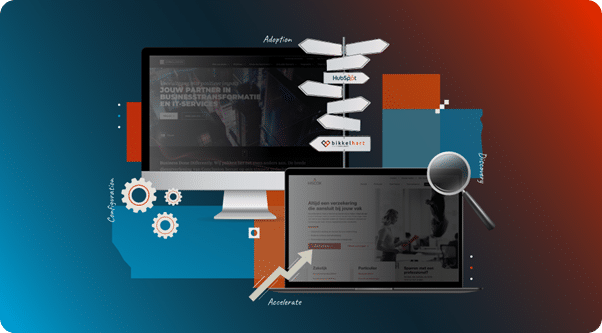
Common bottlenecks?
Data scattered across different systems. Teams working on their own islands. Marketing and sales that evaluate leads differently. And platforms that are set up primarily from technology, not daily processes.
At Bikkelhart (part of Conclusion), we believe that marketing automation only works when the foundation is right. We’ll show you how we built that foundation together with organizations like Conclusion and Hiscox – and which steps are involved.
The approach: building a solid foundation
1. Discovery: first understand, then furnish
Before we configure anything, we map out the situation:
- What does the customer journey look like?
- What products and propositions are there?
- What is the existing system landscape?
- How do the marketing, sales and service teams now work together?
Based on this, we determine which processes are important to support first, which links are needed and where quick wins lie.
The first insights often arise during this phase. For example, that teams manage the same customer data in three different places. Or that the sales pipeline is not kept up to date anywhere.

2. Configuration: getting the basics right
Then we set up HubSpot to fit the organization:
- Basic settings per team
- Integrations with tools such as Google Analytics, LinkedIn Ads and CRM systems
- Migration and cleanup of existing data
- Training and documentation for users
In many cases, we use AI to accelerate data cleaning and duplicate checking. This not only makes the base cleaner, but also future-proof.
By paying immediate attention to data quality, you reduce the risk of score models becoming unreliable or dashboards giving false insights.
3. Adoption: making sure it works in practice
Good configuration is important, but only when people use the system on a daily basis does real value emerge. “Shit in, is shit out.” If people can’t work well with the system, data quality deteriorates and your analyses don’t add up.
Therefore, we provide intensive guidance for adoption. Consider:
- Practical explanation of new ways of working
- Relevant dashboards that align with targets and consultation structures
- Alignment between marketing and sales on lead definitions
We often see that a few small choices here make all the difference. For example, by discussing the pipeline from HubSpot by default in the sales meeting, or by making clear agreements about enriching lead data.
4. Accelerate: optimize based on data
Once the foundation is in place and teams are actively working in HubSpot, the focus shifts to growth.
Together we analyze where opportunities for improvement lie:
- Which phases in the funnel have the highest failure rates?
- What content leads to quality leads?
- Where is the delay in follow-up?
Based on insights from CRM data, visit reports and customer feedback, we continuously adjust processes, campaigns and sales materials. AI helps to recognize patterns faster, but choices are always made together with people who know the context.
Cases: proven in practice
Conclusion: 42 companies, one central structure
The 42 Conclusion companies each individually work from the passion for their own specialty, but with the drive to realize better solutions together. This unique approach offers clients the advantage of a complete service provider, combined with far-reaching expertise in specific sub-topics.
The challenge lies in the sales approach, and that’s where HubSpot comes in. The question was: how do you maintain the diversity but create general overview and even more collaboration/cross sell?
We set up one HubSpot environment in which:
- Sales processes are standardized where necessary
- Labels continue to work flexibly within their own accounts
- Insights about networks, pipelines, and customer relationships can be shared
The biggest win? Sales staff now all work from the same system, with uniform data and a shared understanding of opportunities and relationships.
Hiscox: marketing, sales and service connected in one platform
At Hiscox, another challenge was at play: lead follow-up, sales activities and service inquiries were handled in different systems.
By bringing marketing, sales and service together in HubSpot:
- Can transfer marketing leads directly with the right context
- Scores sales leads based on behavior and interactions
- Every customer request from service is tracked and used to improve campaigns
With short feedback loops between teams, the connection to the customer journey has become much stronger.
The success formula of Bikkelhart
What makes this approach different from others? It’s in the combination of people and technology. We believe in:
- AI as an accelerator: For data cleansing, lead scoring, behavioral analysis and real-time insights.
- Human in the loop: Experts who understand processes and make sure technology is really used.
- Central data as a source of truth: No fragmentation, but one truth for all.
We do not just build systems, but create real transformations.
This article was written by Ralph Kaan, Growth & Content Director at Bikkelhart. Bikkelhart is sponsor of the 2025 DDMA EMAS (Email Marketing Automation Summit).
Ook interessant

Vacature: Lid DDMA Commissie E-mail (op vrijwilligersbasis)

Drukte in de inbox: 7 lessen voor piekmomenten in e-mailmarketing


